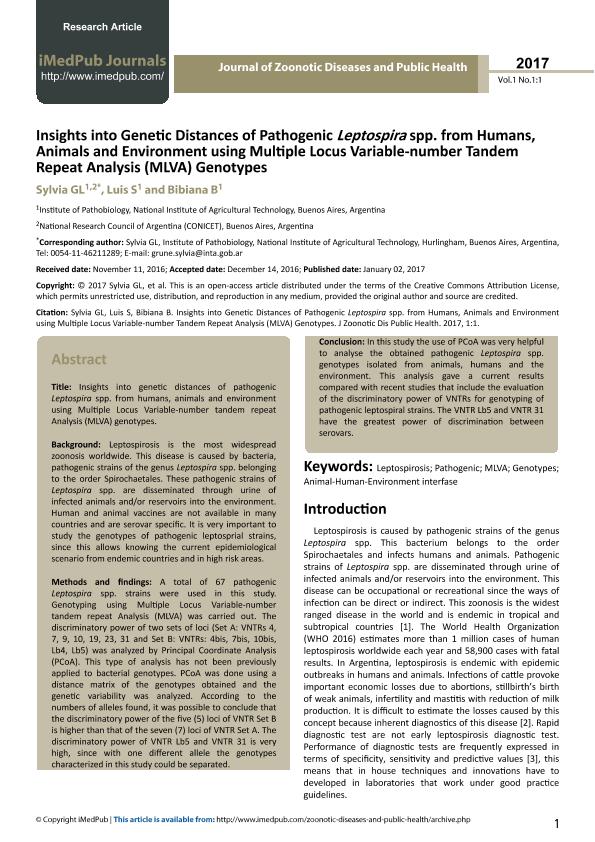Artículo
Insights into genetic distances of pathogenic Leptospira spp. from humans, animals and environment using Multiple Locus Variable-number tandem repeat Analysis (MLVA) genotypes
Fecha de publicación:
01/2017
Editorial:
iMedPub
Revista:
Journal of Zoonotic Diseases and Public Health
ISSN:
0093-3821
Idioma:
Inglés
Tipo de recurso:
Artículo publicado
Clasificación temática:
Resumen
Background: Leptospirosis is the most widespread zoonosis worldwide. This disease is caused by bacteria, pathogenic strains of the genus Leptospira spp. belonging to the order Spirochaetales. These pathogenic strains of Leptospira spp. are disseminated through urine of infected animals and/or reservoirs into the environment. Human and animal vaccines are not available in many countries and are serovar specific. It is very important to study the genotypes of pathogenic leptosprial strains, since this allows knowing the current epidemiological scenario from endemic countries and in high risk areas. Methods and findings: A total of 67 pathogenic Leptospira spp. strains were used in this study. Genotyping using Multiple Locus Variable-number tandem repeat Analysis (MLVA) was carried out. The discriminatory power of two sets of loci (Set A: VNTRs 4, 7, 9, 10, 19, 23, 31 and Set B: VNTRs: 4bis, 7bis, 10bis, Lb4, Lb5) was analyzed by Principal Coordinate Analysis (PCoA). This type of analysis has not been previously applied to bacterial genotypes. PCoA was done using a distance matrix of the genotypes obtained and the genetic variability was analyzed. According to the numbers of alleles found, it was possible to conclude that the discriminatory power of the five (5) loci of VNTR Set B is higher than that of the seven (7) loci of VNTR Set A. The discriminatory power of VNTR Lb5 and VNTR 31 is very high, since with one different allele the genotypes characterized in this study could be separated. Conclusion: In this study the use of PCoA was very helpful to analyse the obtained pathogenic Leptospira spp. genotypes isolated from animals, humans and the environment. This analysis gave a current results compared with recent studies that include the evaluation of the discriminatory power of VNTRs for genotyping of pathogenic leptospiral strains. The VNTR Lb5 and VNTR 31 have the greatest power of discrimination between serovars.
Palabras clave:
Leptospirosis
,
Pathogenic
,
Mlva
,
Genotypes
Archivos asociados
Licencia
Identificadores
Colecciones
Articulos(SEDE CENTRAL)
Articulos de SEDE CENTRAL
Articulos de SEDE CENTRAL
Citación
Grune Loffler, Sylvia; Samartino, Luis Ernesto; Brihuega, Bibiana; Insights into genetic distances of pathogenic Leptospira spp. from humans, animals and environment using Multiple Locus Variable-number tandem repeat Analysis (MLVA) genotypes; iMedPub; Journal of Zoonotic Diseases and Public Health; 1; 1; 1-2017; 1-8
Compartir




